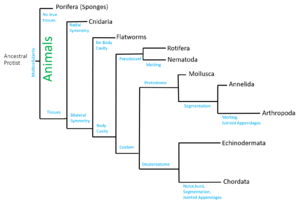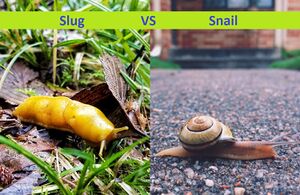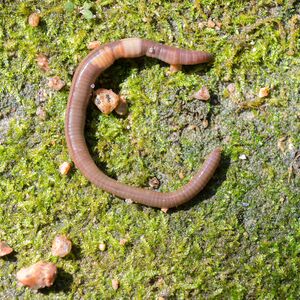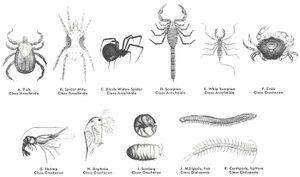Invertebrates
Definition
Invertebrates are any animal that does not have a spinal column. They comprise the vast majority (almost 97%) of all animal species and include a diverse range of organisms, such as insects, crustaceans, worms, and coral.[1] On a phylogenetic tree, invertebrates include all animals that do not fall in the subphylum Vertebrata. Although the term "invertebrates" does not officially define a specific phylum or subphylum like Vertebrata (vertebrates) does, the term has persisted out of convenience.[2]

Soil Invertebrates
The main groups of invertebrates within soil are flatworms (Platyhelminthes), snails and slugs (Mollusca), worms (Annelida), nematodes (Nematoda), and arthropods (Arthropoda).[3]
Flatworms are most diverse in tropical regions and are usually found under rocks or in leaf litter where conditions are humid and moist. They do not have the ability to retain water on their own and will desiccate without an external water source.[4] They are predators and typically eat other invertebrates, including arthropods, earthworms, snails, and slugs. Invasive flatworms can have a damaging effect on an ecosystem when they consume native species. This is especially concerning when native earthworm populations are affected, as earthworms are important soil fauna. [5]

Snails and slugs are typically found in leaf litter in forests, but can also be found in gardens, fields, river banks, and urban areas. Most are considered decomposers and feed on plants, fungi, and algae, but can also consume empty shells, scat, and decaying animals. Some species are carnivorous and will eat nematodes and other snails and slugs. They are also important sources of food for many predators such as beetles, millipedes, small mammals, reptiles, and birds. Snails are important for calcium cycling as they uptake calcium from their food and use it to create their shells, and then are eaten by predators. Calcium availability, soil moisture, and land use strongly affect snail populations.[6]

Although annelids include leeches and ragworms, the most ecologically important type that occurs in soil are earthworms. Earthworms decompose dead organic matter and are major drivers of nutrient and water cycling, plant growth, and changes to soil structure. Some species live at the very surface of soil and within leaf litter, while others live in the upper layer of the soil. Some types are deep burrowers and create permanent burrows several meters long that they use to pull organic matter from the surface down into the soil. Earthworms also consume fungi and bacteria, and are commonly preyed upon by mammals and birds. Since earthworms majorly affect organic matter and microbial populations in soil, they indirectly influence the amount and distribution of other soil fauna.[7] Invasive species of earthworms can also be extremely damaging to ecosystems. Invasive earthworms negatively affect abundance and diversity of both macro- and microorganisms in the soil and cause changes to the physical and chemical properties of the soil. These effects can in turn negatively affect overall ecosystem functioning and services.[8]
Nematodes are small, non-segmented worms that are found in forest, grassland, and agricultural soils. Food sources differ between species, with some nematodes feeding on fungi, others on bacteria, and some on protozoa or other nematodes. They are typically found where their food sources are concentrated. Nematodes are preyed upon by insects and predatory nematodes, and are parasitized by bacteria and fungi. A few species cause diseases in plants, but beneficial nematodes are important for nutrient cycling and dispersing microbes within the soil. [9]

Arthropods are an extremely diverse and prolific group of soil fauna, comprising up to 85% of the species present in soil.[10] They include crustaceans, arachnids, insects, myriapods (centipedes and millipedes), and scorpions. Due to their multitude and diversity, arthropods carry out a wide range of functions and processes within soil. Shredders break down plant litter and residue, contributing to decomposition and nutrient cycling. Some arthropods feed on fungi, which also contributes to nutrient cycling. Arthropods can also be herbivores or predators, and many act as a biocontrol to crop pests or as crop pests themselves. Although some are pests, most arthropods are beneficial to soil ecosystems. The majority inhabit the top few inches of soil, with abundance and species diversity diminishing with depth. [11]
Role in the Ecosystem
Because of their diversity and abundance, soil invertebrates play many roles in the ecosystem. As part of the food web, invertebrates both consume and are a source of food for other organisms, altering the composition and abundance of species of both plants and animals in a community.[12] Many invertebrates are also drivers of nutrient and water cycling. By breaking down decaying plant matter and contributing to decomposition, nutrients such as nitrogen, phosphorus, and carbon become available for plants to uptake, which in turn stimulates plant growth.[13]
They can also be used as bioindicators of soil quality and health. Invertebrate populations are affected by soil contamination, ecosystem clearing, and land management practices. The presence of indicator species and diversity are indicative of higher soil quality.[14]
References
- ↑ Center for Biological Diversity. Invertebrates. https://www.biologicaldiversity.org/species/invertebrates/
- ↑ Louis Aggassiz. (2013). Essay on Classification. Courier Corporation. ISBN 978-0-486-15135-9.
- ↑ Georgia Tech. (2019). Animals: Invertebrates. https://organismalbio.biosci.gatech.edu/biodiversity/animals-invertebrates-2019/
- ↑ Álvarez‐Presas, M., Mateos, E., & Riutort, M. (2018). Hidden diversity in forest soils: Characterization and comparison of terrestrial flatworm’s communities in two national parks in Spain. Ecology and evolution, 8(15), 7386-7400. DOI: 10.1002/ece3.4178
- ↑ Bertone, M., Crawley, S., & Waldvogel, M. (2020). Terrestrial Flatworms, Land Planarians & Hammerhead Worms. https://content.ces.ncsu.edu/terrestrial-flatwormshammerhead-worms
- ↑ Hotopp, K. (2005). Land Snail Ecology. https://www.carnegiemnh.org/science/mollusks/landsnailecology.html
- ↑ Edwards, C. The Living Soil: Earthworms. Natural Resources Conservation Service. https://www.nrcs.usda.gov/wps/portal/nrcs/detailfull/soils/health/biology/?cid=nrcs142p2_053863
- ↑ Ferlian, O., Eisenhauer, N., Aguirrebengoa, M., Camara, M., Ramirez‐Rojas, I., Santos, F., ... & Thakur, M. P. (2018). Invasive earthworms erode soil biodiversity: A meta‐analysis. Journal of Animal Ecology, 87(1), 162-172. DOI: 10.1111/1365-2656.12746
- ↑ Ingham, E. The Living Soil: Nematodes. Natural Resources Conservation Service. https://www.nrcs.usda.gov/wps/portal/nrcs/detailfull/soils/health/biology/?cid=nrcs142p2_053866
- ↑ Bagyaraj, D., Nethravathi, C., & Nitin, K. (2016). Soil Biodiversity and Arthropods: Role in Soil Fertility. In: Chakravarthy, A., Sridhara, S. (eds) Economic and Ecological Significance of Arthropods in Diversified Ecosystems. Springer, Singapore. https://doi.org/10.1007/978-981-10-1524-3_2
- ↑ Moldenke, A. Living Soil: Arthropods. Natural Resource Conservation Service. https://www.nrcs.usda.gov/wps/portal/nrcs/detailfull/soils/health/biology/?cid=nrcs142p2_053861
- ↑ McCary, M. & Schmitz, O. (2021). Invertebrate functional traits and terrestrial nutrient cycling: Insights from a global meta-analysis. Journal of Animal Ecology 90, 1714-1726. DOI: 10.1111/1365-2656.13489
- ↑ Griffiths, H. M., Ashton, L. A., Parr, C. L., & Eggleton, P. (2021). The impact of invertebrate decomposers on plants and soil. New Phytologist, 231(6), 2142-2149. DOI: 10.1111/nph.17553
- ↑ Nuria, R., Jérôme, M., Léonide, C., Christine, R., Gérard, H., Etienne, I., & Patrick, L. (2011). IBQS: A synthetic index of soil quality based on soil macro-invertebrate communities. Soil Biology and Biochemistry, 43(10), 2032-2045. DOI: 10.1016/j.soilbio.2011.05.019